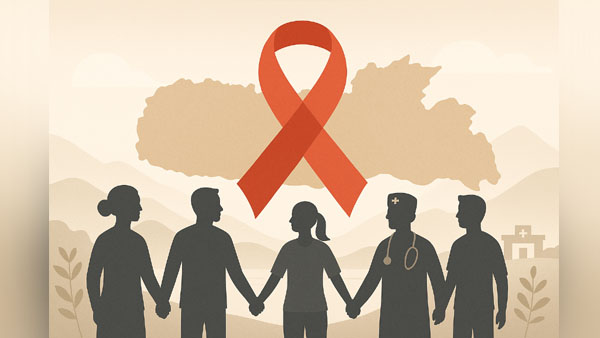By Dipak Kurmi
Meghalaya, a state renowned for its verdant hills and vibrant cultural tapestry, is grappling with a silent yet formidable public health crisis. Over the past 19 years, the state has witnessed a staggering 221.1% increase in HIV/AIDS cases, a statistic that places it among the most affected regions in Northeast India. This alarming surge, as highlighted by Health and Family Welfare Minister Ampareen Lyngdoh on June 17, 2025, underscores the urgent need for a collective, stigma-free response to curb the epidemic. While neighboring Tripura has recorded an even more disconcerting rise of over 330%, Lyngdoh cautioned against using these figures to shame communities, emphasizing instead the necessity for unified action grounded in empathy and understanding. This article delves into the complexities of Meghalaya’s HIV/AIDS crisis, exploring its drivers, the societal challenges impeding progress, and the innovative strategies proposed to address this pressing issue, all while weaving in the minister’s call for a reimagined institutional framework.
The scale of Meghalaya’s HIV/AIDS epidemic is sobering. With an adult HIV prevalence rate of 0.42%—double the national average of 0.21%—the state is home to 9,130 people living with HIV as of June 2024, according to the Meghalaya AIDS Control Society (MACS). The East Khasi Hills district bears the heaviest burden, with 2,611 registered cases, followed closely by West Jaintia Hills (2,441) and East Jaintia Hills (1,976). These figures, coupled with nearly 982 new infections annually, paint a grim picture of a health crisis that demands immediate attention. The National AIDS Control Organisation (NACO) ranks Meghalaya as the fourth-highest state in HIV prevalence, trailing only Mizoram (2.32%), Nagaland (1.45%), and Manipur (1.18%). Among the most vulnerable are children, with 364 minors infected, a revelation made by the National Commission for Protection of Child Rights in 2024. This alarming statistic underscores the intergenerational impact of the epidemic, necessitating targeted interventions to protect the state’s youngest citizens.
The drivers of HIV transmission in Meghalaya are multifaceted, with injecting drug use (IDU) and unprotected sexual activity, particularly involving commercial sex workers, identified as primary contributors. A 2022–2023 survey revealed 3,175 injecting drug users in the state, many of whom are HIV-positive, with 2,350 registered with NGOs affiliated with MACS. The practice of needle-sharing among IDUs significantly amplifies the risk of transmission, a challenge compounded by the state’s proximity to the Golden Triangle, a notorious hub for drug trafficking. Lyngdoh acknowledged this connection, noting that drug use is “quietly becoming a major concern within homes and neighborhoods.” A study in West Jaintia Hills found that 30% of HIV infections in the Northeast are linked to IDU, with women who inject drugs facing a threefold higher risk than men. Commercial sex work, another key vector, is often met with societal judgment, which stifles open dialogue about its role in the epidemic. Lyngdoh questioned whether communities are prepared to engage candidly with the socio-economic factors driving this profession, warning that judgmental attitudes allow the problem to “fester unchecked.”
Societal stigma and lack of awareness remain formidable barriers to addressing the crisis. Lyngdoh expressed concern that many residents do not understand HIV/AIDS, often failing to recognize its symptoms. This ignorance, coupled with the discomfort surrounding public discussions of the disease, delays diagnosis and fuels transmission. The minister’s observations align with a 2024 study in Jaintia Hills, which reported a 5.4% HIV prevalence among youths aged 17–24, with females disproportionately affected. The study highlighted that while 34% of women acquired knowledge about HIV from media and healthcare providers, misconceptions persist, hindering prevention efforts. The stigma surrounding HIV also affects those living with the virus, who face isolation and discrimination, further discouraging them from seeking treatment. Lyngdoh’s call for a “non-judgmental approach” resonates with the need to dismantle these social barriers, fostering an environment where affected individuals can access care without fear.
The government’s response, as outlined by Lyngdoh, centers on the Integrated Health Campaign, a strategic initiative aimed at addressing HIV/AIDS through targeted interventions. This campaign prioritizes vulnerable communities, respecting the privacy of those living with HIV while promoting testing and treatment. However, the minister identified a critical obstacle: the lack of coordination among departments such as health, education, and social welfare. She criticized their siloed operations, which result in “missed targets” and inefficiencies. To address this, Lyngdoh advocated for a unified, cross-sector approach, ensuring that resources are pooled effectively to reduce infections and enhance medical access. The campaign also aligns with preparations for the International Day Against Drug Abuse and Illicit Trafficking on June 26, 2025, themed “Breaking the Chains: Prevention, Treatment, and Recovery for All!” Lyngdoh directed departments to formulate action plans that integrate HIV/AIDS and drug crisis strategies, emphasizing community engagement as a cornerstone of success.
Harm-reduction strategies present both opportunities and ethical dilemmas. Lyngdoh reflected on the practice of providing clean needles to IDUs, a globally recognized method to reduce HIV transmission. However, she highlighted the challenge of implementing such measures without inadvertently normalizing drug use, calling for “urgent discussion” to draw clear ethical boundaries. The state’s efforts to provide opioid substitution therapy (OST) to 2,350 registered IDUs demonstrate a commitment to harm reduction, transitioning users to oral alternatives to curb needle-sharing. Yet, the minister’s concerns underscore the need for a delicate balance, ensuring that interventions prioritize public health without sending mixed messages about drug abuse. Similarly, addressing commercial sex work requires nuanced policies that tackle underlying socio-economic drivers while promoting safer practices, a task Lyngdoh urged communities to approach with empathy rather than judgment.
Community involvement is pivotal to the state’s strategy. Lyngdoh appealed to legislators, Members of District Councils (MDCs), and public leaders to “walk the extra mile,” fostering open dialogue and leading by example. The government’s plan to strengthen Village Defense Parties (VDPs) to combat drug trafficking reflects this community-oriented approach. In 2024, Social Welfare Minister Paul Lyngdoh noted that only 11 active VDPs operated in Shillong, leaving vast areas vulnerable. The revamped VDPs will collaborate with traditional institutions and police to patrol neighborhoods and curb drug-related activities, amplifying community vigilance. Faith-based organizations and NGOs, long-standing partners of MACS, are also critical allies, providing counseling, de-addiction services, and support for people living with HIV. Lyngdoh’s vision of “institutional systems grounded in trust” emphasizes empowering these stakeholders to lead the response, aligning with the 2023 World AIDS Day theme, “Let Communities Lead.”
Meghalaya’s HIV/AIDS crisis is a clarion call for systemic reform. Lyngdoh’s assertion that the state has reached a “critical stage” where restructuring is “urgent” reflects the need to reimagine healthcare delivery, public awareness, and community engagement. The minister’s emphasis on trust-building resonates with NACO’s vision of an India where people living with HIV access quality care with dignity. By fostering collaboration across departments, prioritizing vulnerable groups, and challenging societal stigma, Meghalaya can chart a path toward containing the epidemic. The Integrated Health Campaign, bolstered by community leadership and harm-reduction strategies, offers hope, but its success hinges on sustained commitment and candid dialogue. As Lyngdoh poignantly stated, only by setting aside judgment and embracing empathy can Meghalaya break the chains of HIV/AIDS and drug abuse, forging a healthier future for all its citizens.
(the writer can be reached at dipakkurmiglpltd@gmail.com)




